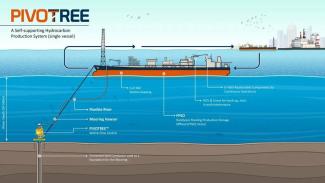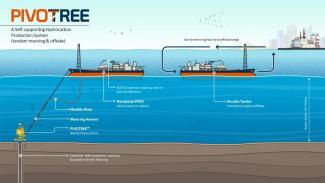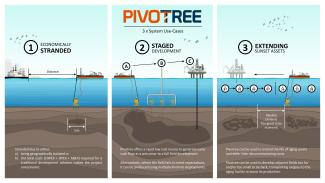Pivotree Self-Supporting Hydrocarbon Production System
Unlocking marginal and stranded fields
The Pivotree Technology is a revolutionary floating development concept and system designed for small, remote offshore oil and gas fields in shallow to mid-water depths (50-500m).
Fields produced using the Pivotree Technology are faster to first production, have vastly lower capital and operating costs, and lower physical impact, when compared to traditional offshore developments.
The step-change in economics is such that many marginal and even stranded fields can now be produced profitably. Estimates using Rystad Energy data suggest the technology could unlock up to 5 billion barrels of production worldwide.
The system is self-sustaining and operates independently of adjacent infrastructure providing a solution to fields that lose their host facility to decommissioning. It can also be used to extend the range of brownfields development, by providing a "floating tieback" to replace complex subsea tie-ins, extending the life of declining facilities and deferring decommissioning burden.
The system has been designed to be reusable, allowing multiple project deployments over a 15 year service life. Breakeven analysis suggests operators can achieve a complete repayment of capital (including drilling and decommissioning costs) on a first project of 9MMbbls or more. Subsequent deployments would then breakeven at an estimated 3MMbbls. These estimate assume an average oil price of only USD $50/bbl.
The system consists of 1) a subsea Pivotree Subsea Unit; 2) a Floating Production Storage and Offtake (FPSO) facility; and 3) the connections between the Subsea Unit and the FPSO including flexible production riser with integrated power and communications, and the mooring hawser.
The Pivotree Subsea Unit is the core technological innovation. It replaces traditional fixed platforms and anchors, providing simultaneous well access, injection, flow control, and 360-degree vessel station-keeping. This subsea mooring and production tree eliminates the need for seafloor pipelines, umbilicals, manifolds, and platform modifications.
The FPSO facility design is based on a Handysize vessel hull with topsides that handle separation, gas treatment, compression, storage, and offloading. The FPSO facility is powered and can disconnect and reconnect throughout the project to transport cargoes to offtake, or can remain on station with shuttle tankers using tandem mooring cargo offloading. Topsides designs can take advantage of the latest developments to manage excess gas and other contaminants, eliminate routine flaring, and reduce CO2 emissions.
Please note; the FPSO facility and connections to the Pivotree Subsea Unit are not included in Pivotree's scope of supply. Pivotree works in collaboration with customers to finalise the design and procurement of these elements of the system.
This revolutionary technology is soon to be independently certified as field-ready by DNV and is protected by a growing patent portfolio.
| Specification Title | Specification Description |
|---|---|
|
Marginal or Stranded Field
|
Unlocks marginal or stranded fields, that are a combination of either being too small and/or too remote to justify a conventional independent production facility or subsea tieback.
|
|
Early Production System
|
The system can be used to produce difficult to appraise reservoirs, generating early production data and cash flows.
|
|
Sequential Developments
|
Agile operators can use the system to produce larger fields in a sequential fashion, with the Pivotree Subsea Unit and Handysized FPSO being redeployed over their service life.
|
|
Extending Sunset Assets
|
Pivotree can be used to extend the life of facilities with declining production that have exhausted nearby subsea tiebacks, by bringing production from fields beyond the reach of economically viable subsea pipeline tiebacks to the host facility.
|
Reviews
Sign up or log in to your explorer or platform subscription to get access to the reviews written about this technology.
The Technology Readiness Level (TRL) indicates the maturity level of novel technologies. Learn more about the TRL scale used by us.
[6/9]





